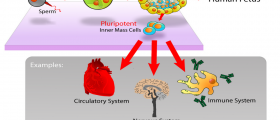
According to the Science Journal, the top scientific breakthrough of the year 2008 was a research that produced "made-to-order" cell lines by reprogramming cells from sick patients. This kind of procedure is also known as cellular reprogramming. Breakthrough of the year is the most significant scientific accomplishment and cellular reprogramming offers a hope to use its techniques to cure difficult-to-study diseases such as Parkinson's disease and type 1 diabetes. Cellular reprogramming opens a completely new field of biology and offers a hope of life-saving medical advances.
Understanding stem cells
Stem cells are cells found in all multi-cellular organisms. Stem cells posses the ability to regenerate themselves through mitotic cell division and differentiate into a diverse range of specialized cell types. Cells are functional basic units of life and all living organisms are composed of cells. These building block of life are the smallest units of life, with a typical size of 10 µm. The two main types of human stem cells are: embryonic stem cells, isolated from the inner cell mass of blastocysts, and adult stem cells, found in adult tissues. Embryonic stem cells are unspecialized and, during the development of embryo, these cells can differentiate in various specialized cells and tissues. These stem cells can be distinguished from the specialized cells by their surface proteins. In the specialized adult cells, genetic codes are “silenced”, but scientists are now able to “turn on” these silenced codes, and revert the adult cell into the more flexible stem cell.Promises of cell reprogramming
There is a long use of adult stem cells in various scientific researches and therapy, and it is not as controversial as the use of embryonic stem cells. This is because the production of adult stem cells does not require the destruction of an embryo. Adult stem cells have been successfully used to treat leukemia and other bone/blood cancers through bone marrow transplants.
Continuing researches in the field of biomedicine have revealed evidence which would suggest that independent adult cells within the body could be reprogrammed from one cell type to another. This would make a strong impact in all areas of medicine. The cellular reprogramming could wipe away the issues involving the use of stem cells, but it could also eliminate the risk that some stem cells may later develop into tumors, which happens if a stem cell is introduced without reprogramming.
Parkinson’s disease, for example, is a condition in which the cells in the brain progressively degenerate and die, causing the uncontrolled movements, tremors and spasms. Until recently, there was no hope for patients with Parkinson’s disease because there was no way to renew the specialized nerve cells that died. However, reprogramming of stem cells into brain cells offers a strong hope that patients with Parkinson’s disease may one day restore their movement control. Stem cell reprogramming may also help in treatment of type I diabetes, by replacing the damaged beta cells of the pancreas.

















Your thoughts on this
Loading...